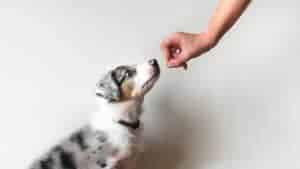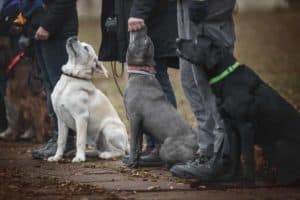
Having a new puppy is akin to welcoming a new family member. There’s a new baby for everyone to cuddle and fuss over. Especially for children, it’s as if they’ve got a new playmate.
But from day one, watch for potential warning signs of an aggressive puppy. Your new puppy might create worry rather than fill your family with joy.
After all, it’s normal to feel concerned about a puppy’s aggressive behavior and whether he will grow out of it. More than just destroying things, there’s also an imminent danger the puppy could cause more harm than good.
The odds are good that your puppy’s disposition is perfectly normal, but exceptions exist. As a rule, there are warning signs if you have an aggressive puppy. Watch your puppy’s body language.
You must recognize whether you can manage your puppy’s aggression or determine whether a puppy lacks the appropriate temperament to be a family pet and could be a dangerous liability.
Deciding whether puppy aggression is just playing or something more serious is also crucial.
Never excuse or ignore undesirable dog behavior issues. Without help, an aggressive puppy will undoubtedly become a dangerous dog.
When well-informed, however, you can turn a negative disposition into a more positive one. This way, your puppy still has hope before it’s too late.
Any breed can produce an aggressive puppy

Often, puppy fear can become puppy aggression. Positive reinforcement training helps dogs behave well and prevents fear aggression in puppies without using punishment.
Puppy aggression is not breed-specific. As sweet, loving, friendly dogs exist in every breed, so do aggressive dogs. No single breed is an exception.
Your responsibility as a pet parent is to be open-minded when you see a problem. That means taking immediate and appropriate action at any sign of aggression.
Wishful thinking that things will change is not the answer. Act quickly to redirect your puppy’s aggression toward positive behavior, which will increase the likelihood of resolving it.
But you may be wondering how to stop puppy aggression.
The first thing you should do is speak to your veterinarian. Have your vet examine your puppy.
Medical, genetic, or other pressing matters may require immediate attention.
The longer you wait, the harder it could be to correct. A vet is an expert who can help you tame any aggressive tendencies you may discover.
Unless there is a severe genetic or neurological problem, the younger a puppy is, the easier it is to modify inappropriate behaviors.
Often, puppy fear or separation anxiety can become aggression. Positive reinforcement or punishment-free obedience training helps create a well-behaved, well-mannered dog and prevents fear aggression in puppies. It can also stop excessive puppy barking.
Understanding how to teach a dog social skills is critical. Think of this as how you’d train and enforce your baby’s positive attitude.
Since their minds work like sponges, the earlier you discipline them, the better. Obedience training is easier to grasp. Start by focusing on basic commands and potty training.
Trained dogs that listen to you and make eye contact are less likely to have behavior problems.
Signs of aggression in dogs include snarling, growling, snapping, biting, possessiveness, and a challenging or aggressive stance.
Now, what are the aggressive puppy signs? Here are a few:
- Puppy won’t stop biting
- Non-stop barking
- Possessive of toys or food
- High prey drive
- Dominant behavior
- Your puppy is hyper and biting at night
Watch your puppy’s behavior around areas where there is food. Early signs of aggression in puppies include being possessive over toys and food.
Is your puppy protective of his food bowl? How do they growl or snarl as you walk by their food bowl while eating? Do they growl or snap when you reach for their food bowl, even if it’s empty?
Do they snatch treats or food out of your hand? Does your puppy lunge, growl, or snap as you attempt to retrieve a dropped piece of food? Are they protective of the trash container?
Does your puppy claim furniture like a chair, couch, or bed? Is your puppy possessive of toys or other items, especially items that might belong to your children?
How does the puppy act when someone, especially someone they don’t know, walks into the house or enters a room? Does the puppy react differently when an unfamiliar child comes to the house? Or does your puppy bark excessively? Are you struggling with a puppy that won’t stop biting?
Does the puppy exhibit an unusually high prey drive by chasing and nipping at anything moving? Do they overreact aggressively to playful teasing, sudden movements, awakening from a deep sleep, or being corrected? Or are they unwilling to be touched?
Watch for warning signs when you pick up the dog, especially puppy nipping, which can quickly turn into a puppy biting your hands.
Your puppy mustn’t act aggressively and bite you when you need to lift or hold them.
Also, watch how your puppy reacts to other dogs and puppies. Look for signs of a dominant puppy.
Does your puppy try to dominate other puppies or adult dogs? Curb that type of early aggression immediately with training.
Teething, nipping, and biting

Know the difference between puppy teething, puppy nipping, and puppy biting. Start training a puppy early so it learns not to bite. Biting training is essential to having a well-behaved dog.
Most puppies learn bite inhibition from their parents or littermates. But you must teach them how to control their bites if they haven’t. Puppy teeth can be needle-sharp compared to adult teeth.
If your puppy does not receive proper training to refrain from biting from an early stage of development, you may get into trouble.
According to dog bite laws, owners are liable for dog bites in some states regardless of the owner’s previous knowledge of the dog’s tendency to bite.
Even if your puppy does not know better yet, you do not want to learn the average payout for a dog bite from personal experience in a courtroom or an attorney’s office.
Indeed, any dog’s intentional provocation will most likely excuse a dog owner’s liability, even in those states with strict liability laws. However, since it is your responsibility if your dog bites, preventing that behavior would be best.
The situation becomes more complicated if your dog bites a child or if the bite leads to cuts, lacerations, ligament and tendon damage, and so on.
In other words, teaching your puppy to stop biting is a crucial responsibility for the greater good of others and your (legal) peace of mind.
Cope with puppy teething
When puppies are teething, their mouths hurt, and they bite or chew to alleviate that pain.
Give your dog appropriate chew toys or teething toys. Most dogs will be distracted and begin chewing the toy.
But if you are coping with an aggressive puppy, you’ll likely wonder how to stop a dog from chewing everything he sees and how to stop puppy-mouthing.
If your teething puppy tries biting you, teach your puppy that it’s inappropriate puppy behavior.
Turn your back, walk away, or say “ow” loudly and high-pitched. Doing so will help teach your puppy not to bite you.
How to stop a puppy from nipping
If your dog playfully nips at you but doesn’t break the skin, you must be cautious to keep playtime from getting too rough.
A nipping puppy can be playful, but after 15 weeks, puppies should not try to touch human skin with their teeth. Compared to adult teeth, your puppy teeth are razor sharp.
If the dog continues to nip or bite you after that time, you must use training to stop that behavior. Never hit a puppy that bites. And don’t bite back.
Instead, when you want your puppy to stop nipping, stop playtime and walk away. Your puppy should quickly learn that you will ignore him if he misbehaves or plays too roughly.
If you’re struggling with this issue, avoid rough play. It would be best if you also skipped play biting.
How to stop a puppy from biting
Be concerned if your puppy bites or tries to bite you every time you touch it. If your puppy bites you, the dog will not show any restraint with anyone else, especially children.
People coping with aggressive puppies become frustrated and may wonder:
- What can I do? My puppy won’t stop biting me. I’ve tried everything
- Why do puppies bite so much, and
- How to stop my puppy from biting
If your puppy aggressively or viciously tries to bite, or if a snarl accompanies the attempt to bite, you must learn how to stop the puppy from biting fast.
It’s also dangerous if your puppy tries to bite your face or if your puppy tries to bite other dogs or other people, especially children.
If your puppy becomes aggressive about biting or if the bite breaks the skin or causes bleeding, it’s a sign the dog is trying to be dominant.
You must immediately take action when a puppy won’t stop biting and can’t be distracted by treats or commands.

If it’s possible to modify or change your puppy’s inappropriate behavior, consult with a responsible dog trainer who applies positive reinforcement, punishment-free methods of training
Now, you also may ask, how to deal with aggressive behavior?
Thankfully, there are things you can do if you’re concerned about your puppy’s temperament.
Always start by having your puppy examined by your veterinarian.
Your options will be limited if your dog has inherited or neurological problems.
Use socialization to mitigate potential aggression
Socializing a puppy is crucial in preventing aggressive tendencies as it helps them become well-adjusted and confident adults.
The process should begin as early as possible, ideally when the puppy is between 3 and 14 weeks old, as this is the critical period for social development.
During this time, introduce your puppy to various people, other animals, and different environments. This exposure helps them learn appropriate behaviors and reduces fear of unfamiliar situations.
Positive experiences are essential; ensure that interactions are supervised and that the puppy receives praise and treats for calm behavior.
Group training classes can also be beneficial, providing structured socialization under controlled circumstances.
Consistency is vital—regularly exposing your puppy to new experiences will help them build trust and resilience, ultimately resulting in a well-rounded dog that is less likely to display aggression.
Always be patient and attentive to their reactions, adjusting the socialization approach to keep the experience positive and enriching.

Use positive reinforcement
Positive reinforcement training can significantly reduce aggressive tendencies in puppies by encouraging desirable behaviors and building a trusting bond between the dog and its owner.
Start by identifying situations that trigger aggressive reactions, such as certain stimuli or interactions. When your puppy remains calm, immediately offer praise, treats, or toys to reinforce their good behavior.
Maintaining a consistent training routine is essential, as positive reinforcement works best when the pup knows what behaviors are expected.
Keep training sessions short and fun, ensuring your puppy stays engaged and motivated.
Socialization is also key; gradually introduce your puppy to new people, animals, and environments, rewarding them for appropriate responses.
If your puppy displays aggressive tendencies, redirect their focus to a toy or a command rather than punishing them, as negative feedback can exacerbate anxiety and aggression.
Finally, be patient and understanding, as these behaviors take time to modify. With consistent positive reinforcement, you can help your puppy learn to navigate challenges without resorting to aggression.

Learn to recognize fear and anxiety
Recognizing and addressing signs of fear or anxiety in puppies is crucial for their development and well-being.
If you don’t help your puppy develop coping skills, fear and anxiety can transform into aggression.
Common indicators of fear include cowering, whining, hiding, or attempting to escape from a situation. You may also notice physical signs such as flattened ears, tucked tails, and tense body posture.
Pay attention to your puppy’s reactions to various stimuli, such as loud noises or sudden movements, as these can often trigger anxiety.
To address these issues, create a safe space where your puppy can retreat when feeling overwhelmed.
Gradually desensitizing them to the sources of their fear through controlled exposure and positive reinforcement can help them build confidence.
Avoiding punishment is essential, as it can exacerbate fear and anxiety. Instead, focus on reinforcing calm behavior with treats and praise.
Socialization, regular exercise, and mental stimulation can further alleviate symptoms, helping your puppy feel more secure and relaxed in its environment.
Don’t wait if you spot aggressive puppy warning signs
Intervening early when spotting aggressive puppy warning signs is crucial for their development and the safety of the dog and the people around it.
Puppies, like children, are still learning how to navigate their environment and interact with others.
Aggressive behaviors, such as growling, snapping, or biting, can become ingrained if not addressed promptly.
Ignoring these signs can escalate aggression, resulting in a more significant behavior problem as the dog matures.
This poses a risk of injury to people and other animals and can create a challenging living situation for the owner.
Unaddressed aggressive tendencies can lead to the puppy being rehomed or even euthanized, as many owners may feel overwhelmed or unsafe.
Intervening early can involve positive reinforcement training, socialization with other dogs, and guidance from a professional trainer. These can help guide the puppy towards more assertive but appropriate behaviors.
Addressing aggression early lays the foundation for a well-balanced, confident adult dog, ensures a safe environment, and fosters a deeper bond between the owner and the pet.

Work with a trainer or behaviorist
If you want your puppy to stop unacceptable behavior, consult a responsible dog trainer who applies positive reinforcement and punishment-free training methods.
The trainer must have experience working with aggressive dogs.
Standard recommendations like crate training, exercise, and sufficient stimulation can also help.
Consider using dog training books to boost your skills. Use training treats to reward good behavior.
Alternatively, you can begin puppy obedience training at home. Reward-based training strengthens the relationship between you and your puppy and makes your dog feel more comfortable at home.
Teaching your simple dog commands such as sit, stay, come, and leave it are all excellent, helpful training commands that will help stimulate your dog’s mind.
A second option is to consult with a dog behaviorist. Temperament tests are available to evaluate if there is a problem or how serious it may be.
Be warned that some symptoms of puppy aggression mimic those of canine autism and canine ADHD.
Behavior modification is not fast or straightforward. It often takes time to undo bad behavior before creating new, better habits. It requires significant time, energy, and patience and can be expensive.
Nonetheless, it could make the difference between keeping your puppy and the alternative.
Work with your puppy and watch how it responds to training cues and discipline. You may need to modify your approach. Always remember to keep training sessions short and fun.
One case study involved a 6-month-old puppy displaying aggressive behavior towards other dogs and people.
The owner worked with a professional dog trainer to implement positive reinforcement training techniques, such as rewarding calm behavior and redirecting aggressive tendencies.
Over time, the puppy’s behavior improved significantly, and it could socialize with other dogs and people without displaying aggression.
Another example is a puppy that was exhibiting territorial aggression towards family members.
Through behavior modification techniques, such as desensitization and counter-conditioning, the puppy learned to associate the presence of family members with positive experiences, reducing aggressive behavior.
Examples and case studies of how training and behavior modification successfully addressed puppy aggression can provide valuable insights into effective strategies for dealing with this issue.

Aggression caused by illness
Consult your vet if your puppy or older dog shows unexplained aggressive tendencies. Your dog may suffer from rage syndrome.
Some believe rage syndrome is rare, but research suggests seizures can also lead to aggression.
Partial complex seizures happen when abnormal electrical activity occurs in the brain’s temporal lobe, where memory, emotions, and senses are located. This can cause defensive or predatory behavior, resulting in aggressive outbursts.
Rage syndrome is a severe form of aggression in dogs. It occurs without any specific cause, meaning it is not triggered by factors such as protecting their space or feeling scared or anxious.
While the condition can affect any dog breed, English springer spaniels often display similar symptoms, causing the condition, which is also called “Springer rage.”
Although no treatments cure rage syndrome, anticonvulsant medications like phenobarbital can help manage it.
The medication may work with a single dose, while some dogs require lifelong treatment and regular blood tests to monitor the effects.
Your family should consider any changes in your dog’s behavior that could indicate aggression. If necessary, modify your interactions with your dog during those times.
You may have to consider euthanasia if the aggression becomes unmanageable.
Help aggressive puppies
These are just a few of the most common warning signs and suggestions for handling potential problems. Know the difference between normal puppy behavior and aggression.
Also, recognize that, like small children, puppies can struggle at critical times during the day.
For example, some puppies experience witching hours in the early evening. Being hungry or tired can trigger puppy aggression.
Puppies can also exhibit destructive behavior when they are bored. Ensure your puppy gets enough exercise, and consider using puzzle toys to provide mental stimulation.
Be cautious, however, as overstimulation can also cause aggression. Make sure your puppy gets enough sleep.
Socialization is essential in preventing aggression and anxiety.
You may wonder, “Why is my puppy growling and biting?” Your puppy may growl or bite due to teething, a desire to play, or general puppy behavior. But it could also be a sign of fear or aggressive tendencies.
If you spot aggressive puppy signs, don’t wait—act immediately by bringing the pup to the vet. Keep an open mind.
If you can’t fix the problem medically or modify your puppy’s behavior by training your dog or working with a professional dog trainer, you will have a difficult choice.
Do not pass the problem on to someone else by surrendering the animal to a shelter or rescue. Do the responsible thing.
When you act on your puppy’s aggressive tendencies, who knows, you may be able to correct it early so your puppy grows into a loving family pet that your family will truly love.
